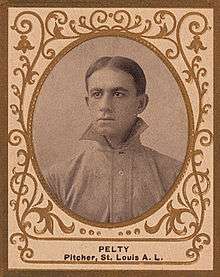Barney Pelty
| Barney Pelty | |||
|---|---|---|---|
 | |||
| Starting pitcher | |||
|
Born: September 10, 1880 Farmington, Missouri | |||
|
Died: May 24, 1939 (aged 58) Farmington, Missouri | |||
| |||
| MLB debut | |||
| August 20, 1903, for the St. Louis Browns | |||
| Last MLB appearance | |||
| August 10, 1912, for the Washington Senators | |||
| MLB statistics | |||
| Win–loss record | 92–117 | ||
| Earned run average | 2.63 | ||
| Strikeouts | 693 | ||
| Teams | |||
Barney Pelty (September 10, 1880 – May 24, 1939), was a major league baseball pitcher known as "the Yiddish Curver" because he was one of the first Jewish baseball players in the American League. His career ERA is 2.63, 60th-best of all pitchers in major league baseball. Through 2006 he ranks 71st in hits per 9 innings, and 48th in batters plunked.
He was one of the best Jewish pitchers in major league history, ranking first through 2010 in career ERA (ahead of # 2 Sandy Koufax), 6th in wins (92), and 7th in strikeouts (693).[1]
He was born and died in Farmington, Missouri.
College
Pelty was offered free tuition at the now-defunct Carlton Institute in Farmington, Missouri to pitch for them. While attending Carlton, he met Eva Warsing, whom he married. After two years at Carlton, Pelty transferred to Blees Military Academy in Macon, Missouri and pitched for the Academy team in the 1899 and 1900 spring seasons.
Minor league career
Pelty began his professional career with the 1902 Nashville Volunteers, but an arm injury cut his season short.
After playing semipro ball, he was signed by the Cedar Rapids Rabbits for 1903.
Major league career
The Boston Red Sox and the St. Louis Browns got into a bidding war for him in 1903, and the Browns won with an offer of $850 ($22,000 today). He became a coach when not pitching.
He was a workhorse for the St. Louis Browns, a member of their starting rotation from 1904, when he pitched 31 complete games and 301 innings, through 1911.
In 1904 he led the league in hit batsmen (20), and was 6th in wild pitches (9).
In 1905 he was 14–14 with a 2.75 ERA, while the team's other pitchers were a combined 40–85.
His peak year was 1906, when he went 16–11 with a 1.59 ERA (2nd in the AL). He also led the league in fewest hits allowed per 9 innings pitched (6.53) and lowest batting average (.206), and was 2nd in hit batsmen (19). He especially was dominant against the World Series champion 1906 White Sox, allowing one run in 32 innings. In one three-game series against Chicago, Pelty pitched every game, including a 0–0 tie in 10 innings. His 1.59 ERA is the lowest in the history of the Browns/Baltimore Orioles franchise.
In 1907 he lost a league-high 21 games and hit a league-high 19 batters, while pitching 5 shutouts (6th best in the league) and 29 complete games (also 6th best).
In 1908, the right-hander improved to 7–4, 1.99 in a reduced role.
In 1909 he pitched 5 shutouts, 5th-best in the AL. He also was 10th-best in the league in fewest hits allowed per 9 innings pitched (7.13)
On June 11, 1912, he was purchased by the Washington Senators from the St. Louis Browns. He finished his career with the Senators that year.
He gave up 22 home runs in 1,908 innings in his career. He did not mind pitching inside, leading the league in hit batsmen in 1904 and 1907. While he gave up only 558 earned runs lifetime, errors by his teammates (and by him—he had 12 in 1906) let in nearly another 200 unearned runs lifetime.
Pelty pitched 22 career shutouts, but was shut out 32 times, including nine 1–0 defeats due to poor offensive support.
In his career, through 2010 he was one of the all-time best Jewish pitchers in major league history, ranking first in career ERA (ahead of # 2 Sandy Koufax), 6th in wins (92; directly behind Jason Marquis), and 7th in strikeouts (693; directly behind Barry Latman).[1]
Miscellaneous
- It was often erroneously reported that he had changed his name from Peltheimer.[2]
- Pelty was proud of his Jewish heritage as indicated by his nickname, and did not change his name or hide his identity like some other Jewish players of the era.
- During his career, Pelty ran a bookstore in his Farmington hometown in the off-seasons. He worked as an inspector for the Missouri State Food and Drug Department, and was an alderman for several terms in Farmington.
- Pelty pitched one last game in 1937 in an exhibition against Grover Cleveland Alexander, dropping the decision.
See also
- List of Major League Baseball career hit batsmen leaders
- Jews and Baseball: An American Love Story, 2010 documentary
- List of select Jewish baseball players
Notes
- 1 2 Jewish Major Leaguers Career Leaders at jewishmajorleaguers.org
- ↑ Barney Pelty at the SABR Bio Project, by Christopher Williams and Robert W. Bigelow, retrieved July 11, 2013 , a biography which originally appeared in David Jones, ed., Deadball Stars of the American League (Washington, D.C.: Potomac Books, Inc., 2006)
Sources
- Horvitz, Peter S. (2001). The Big Book of Jewish Baseball. S P Books. pp. 130–132. ISBN 9781561719730.
- "Pelty, Barney: "The Yiddish Curver"". Jews in Sports. Retrieved 16 March 2014.
External links
- Career statistics and player information from Baseball-Reference, or Fangraphs, or The Baseball Cube, or Baseball-Reference (Minors)
- "Barney Pelty". Find a Grave. Retrieved August 10, 2010.